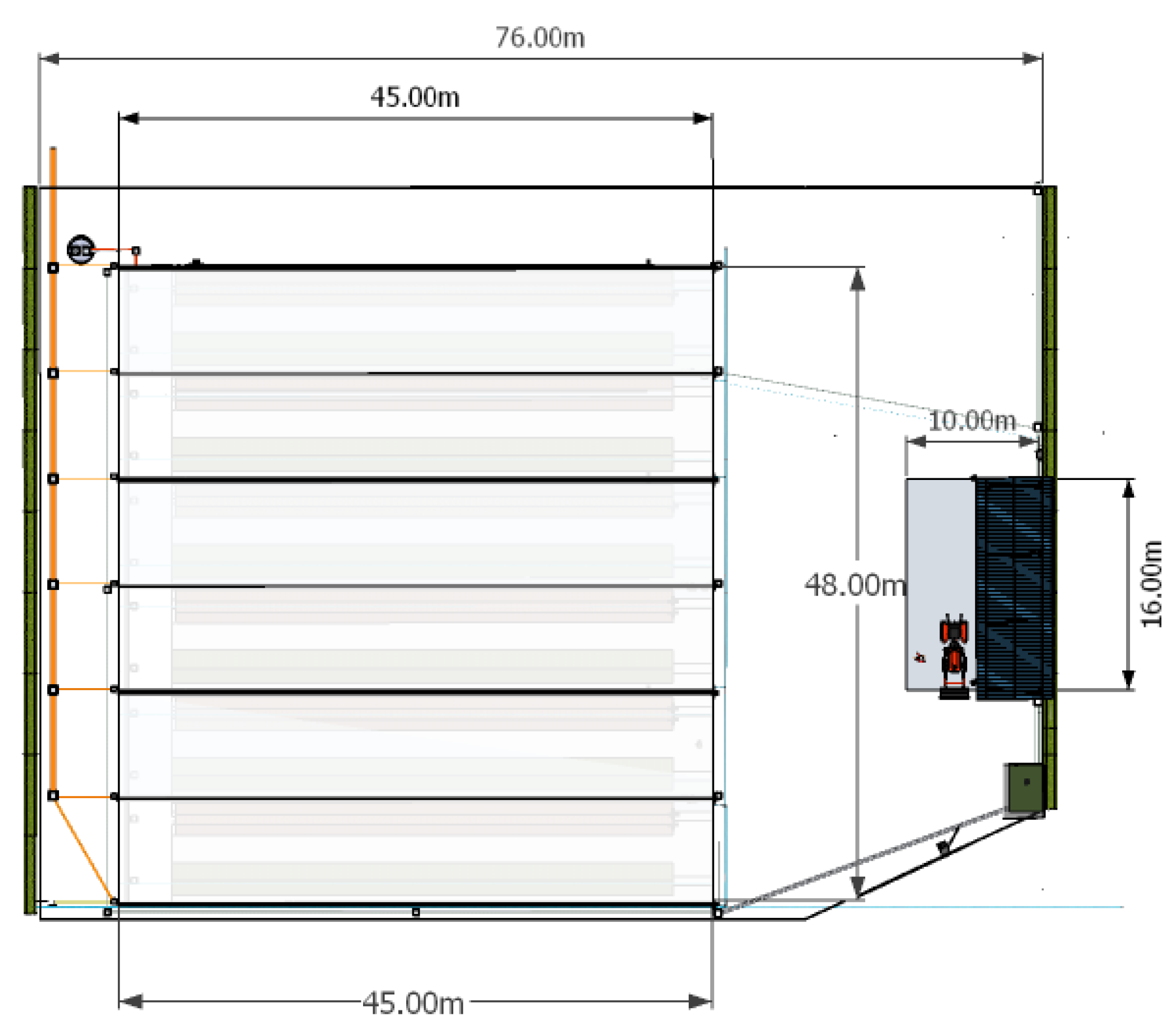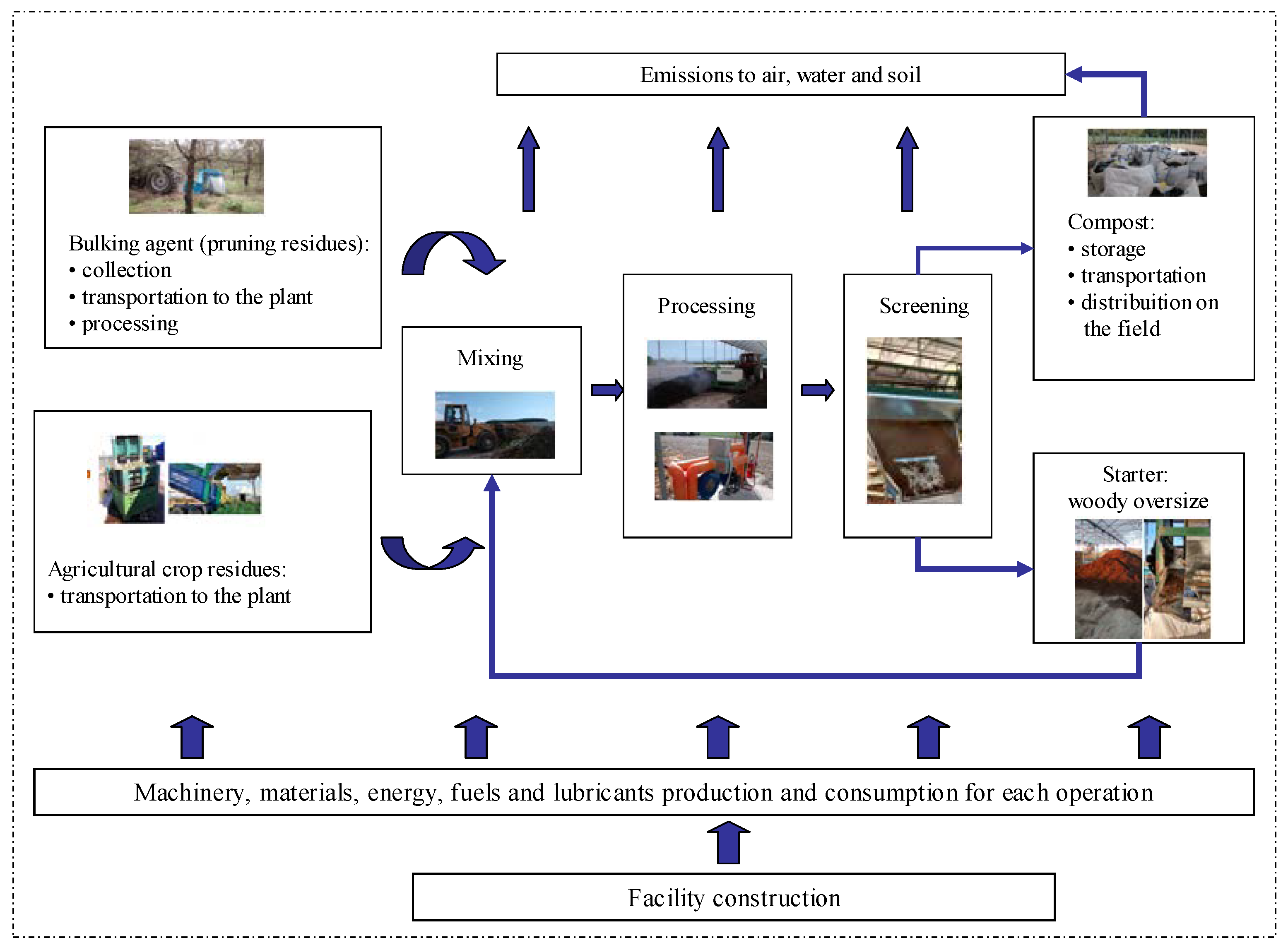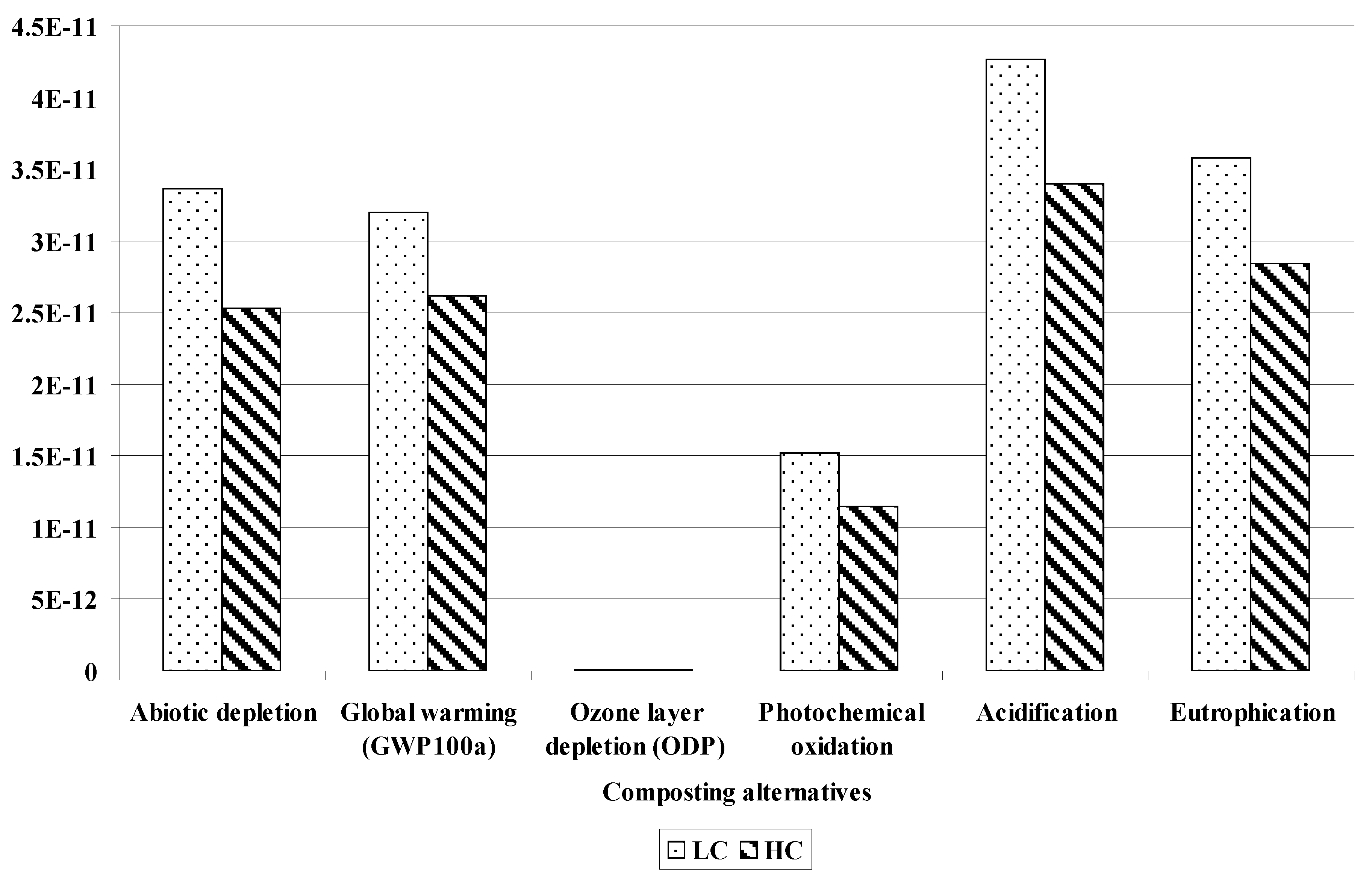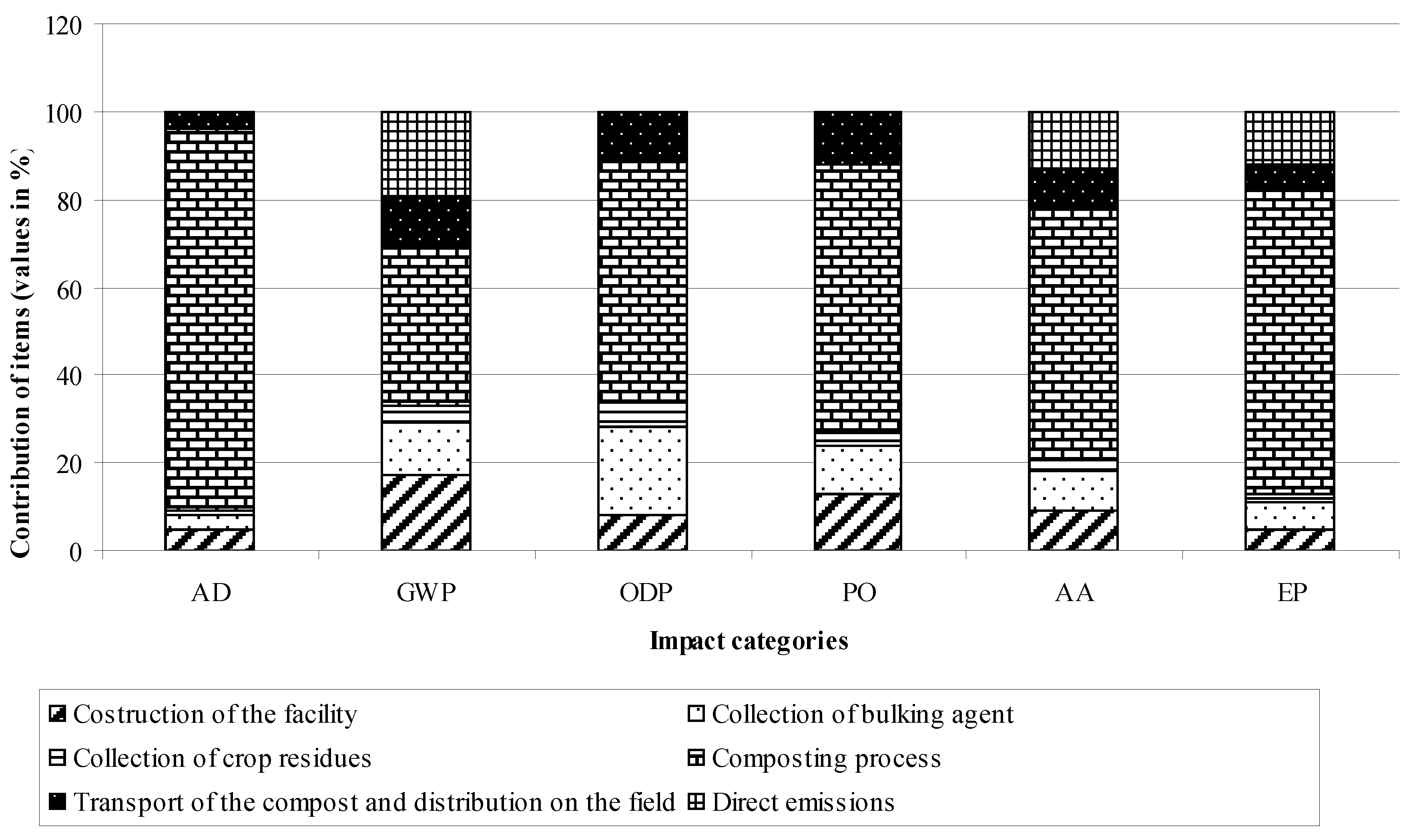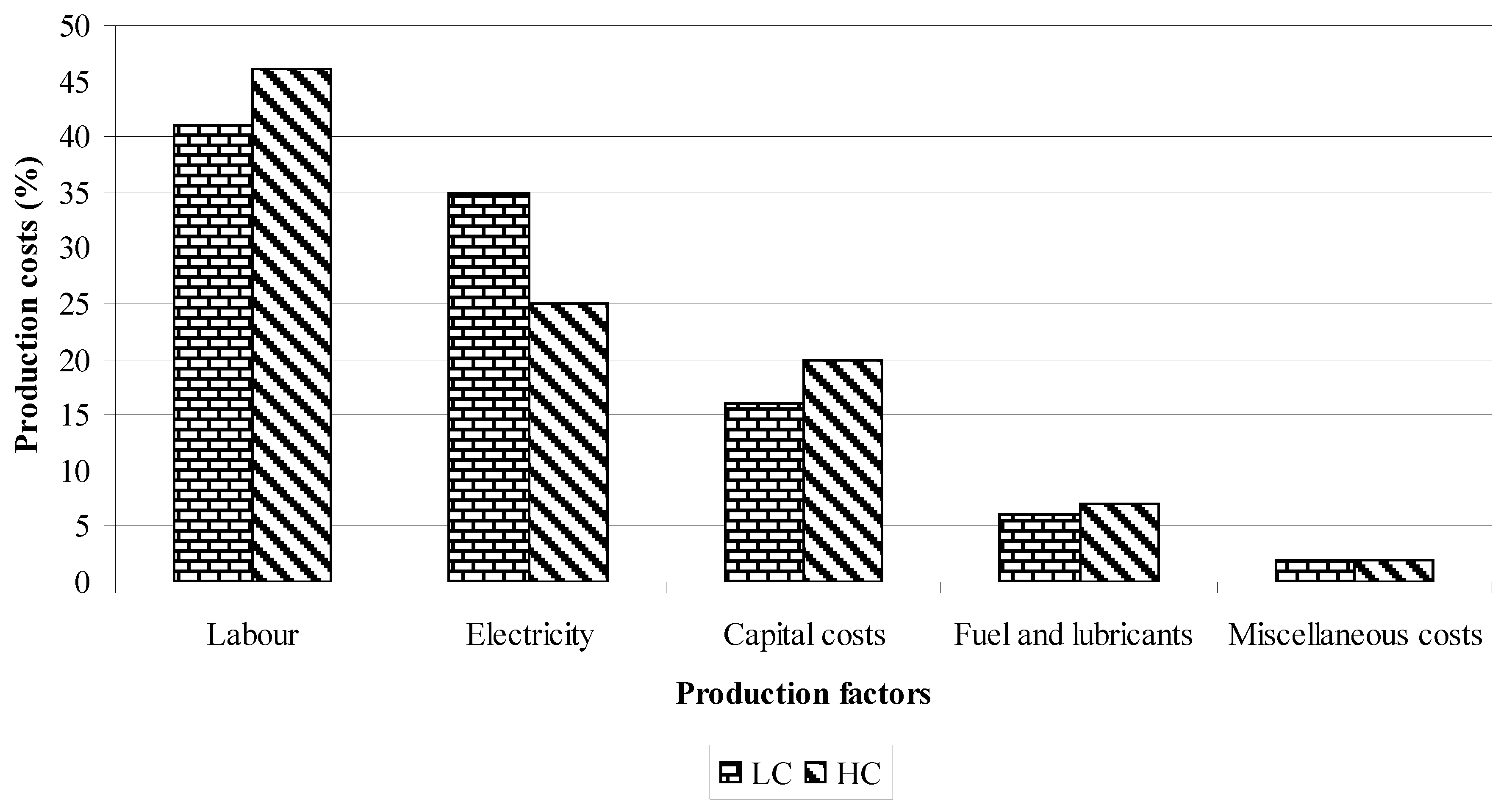1. Introduction
For several years horticultural farms have faced the problem of disposing of vegetable biomasses resulting from residues of agricultural crops and trees. The growing attention of institutions and of the public to environmental issues and the application of the existing legislation [
1] have determined the need to apply sustainable solutions to the management of these agricultural by-products. The supply of livestock feed [
2] is the most common recovery form of these residues. In most cases, this waste, as it is, is delivered at the livestock farms, with contract of assignment, and it is mostly used fresh, as much of it is waste from the processing of vegetables intended for fresh consumption. This type of recovery, however, is not always possible. For instance, tomato peels, corn waste, and other lignocellulosic materials have physical and chemical characteristics such that it is possible to proceed only to their ensiling. Moreover, when the quality of the waste is not suitable for animal feed (i.e., for the presence of soil particles dirtying crop residues), waste is intended at the agronomic use on the land. At the same time, this practice is quite easy for residues produced in the field but not for those produced in warehouses and processing units of agricultural products. In fact, for the latter there are additional important costs (i.e., loading, transportation, and unloading) and the practice is not achievable when soils are wet. In addition, the continuous vegetable residues supply to the soil could cause the accumulation of pathogens in the field and environmental pollution due to nitrates leaching phenomena.
Green residues, together with waste of agribusiness, can also be used to produce biogas. In this way, farms can produce energy from renewable sources; improve their economy; release lower greenhouse gases; enhance the quality of the fertilizer production; implement the recycling of their waste; cause less pollution from smells; and improve the sanitation conditions of the company [
3]. At the same time, biogas plants have some disadvantages: Agricultural residues should be used in places not far from the biogas plant, since their transport and storage require additional costs and the disposal of the liquid digestate on fields is problematic.
Of great environmental interest are also the experimentations to produce biopolymers from waste materials, such as those derived from food industry (canning, casearia, and tomato processing) but also from algae, corn stubbles, or from the differentiated collection of the organic fraction from municipal waste. Using local agricultural products, the biopolymers can reduce the dependence on imported fossil fuels and increase the demand for products generated by European agriculture, supporting the development of rural areas. The biopolymers also help to create end-of-life options for efficient and sustainable bioplastic waste, because they can be disposed of in several ways as composting [
4].
The most reliable and common practice to the management of agricultural by-products is composting: The only technique that allows the recycling of “green waste”, so that the problem becomes an important factor of production. Composting is a waste management system that creates a recycled product, which is carbon (C) rich and free of most pathogens and weed seeds [
5]. According to Brown et al. [
6], composting can be considered a C-based system, similar to reforestation, agricultural management practices, or other waste management industries and it is one of the most frequently alternatives to landfill [
7]. Composting decreases environmental problems related to waste management by reducing waste volumes and by killing potentially dangerous organisms. The agricultural utilization of compost could meet the target objective of European Union countries to decrease the quantity of organic waste going to landfill sites by 20% by 2010 and by 50% by 2050 [
8].
According to Saer et al. [
9], several studies have shown the environmental benefits of compost use for improving soil quality, such as:
- ✓
Incorporating organic matter [
10,
11,
12], nutrients and electrolytes into the soil [
13];
- ✓
reducing the need for fertilizers [
14], pesticides and peat use [
15], activating a wide ranges of natural disease suppressiveness mechanisms against plants pathogens and bio stimulation able to improve the overall plant status [
16];
- ✓
improving soil structure, density and porosity [
17,
18,
19,
20,
21,
22,
23,
24,
25], which increase water retention capacity and reduce erosion and nutrient leaching [
20,
26]; and
- ✓
enhancing carbon storage capacity in the soil, thus, reducing global warming [
24,
27,
28].
Therefore, increasing attention is devoted to soil management practices aimed to improve both soil organic carbon incorporation and soil organic matter (SOM) accumulation, as the addition of organic materials and, even more, the use of compost obtained by facilities located in agricultural companies. It is therefore possible to switch from a conventional agriculture to an organic one. Despite these environmental benefits, composting could have negative direct and indirect environmental impacts. Referring to direct negative impacts, on one hand, there are CO
2 emissions from decomposing organic matter in compost piles and that usually are not considered as additional GHG emissions since they are biogenic and part of the short-term C cycle [
6]; and on the other hand, there are methane (CH
4), nitrous oxide (N
2O), and ammonia (NH
3) emissions from methanogenic and denitrification processes occurring during the composting process under anaerobic conditions, which result in odor and additional GHG emissions [
29,
30,
31].
Many researches have analyzed indirect emissions by means of life cycle assessment (LCA). As reported in Pergola et al. [
32], some have taken into account the manure processing technologies along the entire life cycle of manure and its end products [
33,
34]; others, industrial composting and waste management systems [
35,
36,
37,
38,
39,
40]; still others, bio waste treatments [
41] and food waste home composting system [
9]. On the contrary, there are no references in literature on the environmental impacts occurring during the on-farm composting of green waste.
In the agricultural sector, another recent topical subject is the energy use. Pergola et al. [
32] have assessed the energy sustainability of one ton of compost from dairy cattle/buffalo manure in two on-farm facilities operating with different bulking agents. Cumulative energy demand has been evaluated by Martínez-Blanco et al. [
42] for home and industrial composting of the source-separated organic fraction of municipal solid waste, and by Colón et al. [
43] for an experimental home composting process of leftovers of raw fruits and vegetables. However, a comprehensive assessment of the compost chain sustainability should also consider an economic perspective. Therefore, the combination of an economic, environmental and energy analysis of a production system may be more useful to find and apply the best management strategies [
32,
44,
45,
46,
47].
The present study is part of the CarbOnFarm project Life+ ENV/IT/000719. The project is focused on the implementation of both demonstrative and innovative strategies based, respectively, on the restoration of SOM function in agricultural soil with local agricultural valorization of recycled waste biomasses, and the soil application of green chemistry products. The project intends to address the target environmental problems related to the decrease of soil organic carbon content and of soil degradation processes of the agricultural areas of Mediterranean countries, which represents a chiefly target objective advised by EU Soil Thematic Strategy. One of the specific objectives of the project is to promote the economic and productive enhancement of residual biomass from agriculture in order to obtain a high-quality compost made with the adoption of on farm facilities. Therefore, the specific aim of the present research was to determine environmental impacts, energy consumptions, and production costs of a windrow composting system using LCA approach to evaluate all the stages of the agricultural green waste composting process, including bulking agent acquisition and transport; agricultural waste transport; and compost production, transport, and distribution on field.
2. Description of the Composting Plant
Composting plant is located in Salerno province (Campania region, Italy), precisely in Eboli (40°33′11.48″ N, 14°57′43.87″ E), and it is managed by a private agricultural farm (Prima Luce) with the aim to develop a prototype of a composting facility based on confined windrows for the production of compost on farm.
This composting plant (
Figure 1) covers a surface area of 4180 m
2 (
Figure 2) and is composed as follows: A proofed concrete bed of 2160 m
2, inclusive of channels and drainage well for liquid residues; covering structures for this 2160 m
2 area; automatic blowing system (5 blowers) for aeration with air pipes; automatic system for the recovery of processing waters (submersible pump); electric control panel inclusive of monitoring probe-systems (temperature, oxygen, humidity, data logger).
The composting process combines an aerated static pile technique with weekly turning windrow cycles. During the first three weeks of the bio-oxidation phase, the fan of the aeration system pushes air almost continuously through the composting mass. In this phase, internal temperature windrow reaches 60 °C at least per 3 days. From the fourth to the seventh week, the blower pushes air according to the following cycle: 5 minutes on, 55 minutes off. During all this period air insufflation is combined with weekly windrow turning. From the eighth week until the end of the process in windrow (60 days, 35–45 °C), the compost is only turned. During the following thirty days the compost is arranged in pile to complete the curing phase controlled by temperature. In the second phase of the composting procedure (around 50 days), the turned windrow composting method is used. The compost mix is aerated by a windrow turner which is powered by a farm tractor (PTO). This combined composting procedure represents a low technology and medium labor approach and produces a uniform compost. In addition, pumps for insufflations is placed on mobile carts in order to reduce handling costs.
The plant is composed of the following parts: area for bulking agent storage (materials with structuring function such as pruning residues, wood chips, straw, etc.); area for mixing vegetable residues, bulking agents and starter; active compost pad; curing pad; screening compost and compost ready to use area; leachate detention pond (
Figure 2). The plant is provided also with an irrigation system and an electricity network.
Agricultural crop residues, treated in the compost-on-farm plant, come from a door-to-door residue collection system from surrounding processing plants for fruit and vegetables adhering to the same consortium of producers and located at different distances from the composting plant. The final compost produced, about 9 tons per week, is used in agriculture by the consortium farms for the production of fruits and greenhouse vegetables.
3. Materials and Methods
The composting plant could treat around 2000 tons of vegetable biomass per year. One of the aims of the U.E. CarbOnFarm project is to involve more farms possible to create a network for the collection of these residues, to remedy the problems associated with their disposal and to produce and use compost on farm without resorting to the market. To encourage operators to implement the composting process it is fundamental to evaluate its environmental, energy, and economic sustainability. For this reason, two composting alternatives were taken into account within this study. The alternatives differed for the organic residues composted: in one case lettuce and other similar “light residues”, in another case heavy biomass, as for example artichokes and cauliflowers residues, tomatoes’ stems or walnut husks. The “light residues” are those with a dry matter content below 8%–10% while the “heavy materials” are those with a dry matter content above 10%. The typology of composting material is very important because it influences the quantity of compost produced. Indeed, in the first case, called from now on “light compost” (LC), were produced 7.5 tons per week; in the second one, called from now on “heavy compost” (HC), were produced 10 tons per week.
As documented in the following sections, the same background conditions—namely the Functional Unit (FU) and the system boundaries—were defined for the development of the three sustainability assessments and, so, the same inventory data was collected and used.
3.1. Environmental Analysis
3.1.1. Goal Definition, Functional Unit, and System Boundary
The goal of the present analysis was to estimate and compare the environmental impacts of two composting alternatives (LC and HC) using the LCA methodology according to ISO 14040 and 14044 standards [
48,
49]. LCA is a methodology for determining the environmental impacts associated with a product, process or service from cradle to grave. The results obtained could be useful for farmers, farmer associations, technicians, and local politicians to solve the problems associated with agricultural wastes disposal through the sustainable production and usage of compost on-farm.
For the purpose of the current investigation, a ton of compost produced (with a 70% dry matter) was chosen as functional unit, namely the reference unit that expressed the function of the system in quantitative terms. At the same time, for the development of the whole assessment, the system boundary chosen was from the extraction of raw materials—passing through bulking agents processing (wood chip of pruning residues—PR), collection of the crop residues from farms, composting process—to final compost destination. As the Recycled Organics Unit [
24] reported, a conventional composting system results in impacts and avoided impacts from a number of individual sub-systems. In this study, these sub-systems included the processing of the pruning residues; the transportation of these materials to the plant; the collection of crop residues and its receipt; the construction of the capital equipment and infrastructures; the compost processing and the transport and distribution on the field of the compost produced. In particular, the system boundary encompassed impacts associated with the construction of the capital equipment or infrastructures in all processes; the fuel usage in the various operations and the electricity used by the composting facility. System boundaries and input and output flows considered are depicted in
Figure 3.
3.1.2. Data Collection and Life Cycle Inventory Analysis (LCIA)
The inventory of the data associated to the studied systems was collected in situ, at the composting plant. Using a data collection sheet, information on the quantities of machinery, fuel, electricity, and other items used were gathered. All items and machinery used in the examined composting systems during the reference period (20 years) are reported in
Table 1 and
Table 2.
Referring to the bulking agent processing, the following farming operations were taken into account: Manual collection of pruning residues from olive orchards, their transport to the composting plant and their chopping at the plant. With respect to the collection of biomasses to be composted, only their transport to the plant was taken into account.
For the construction of the composting facility the following operations were considered: building of composting and blending platform made of concrete; construction of covering structures made of steel and high-density polyethylene; forecourt made of gravel and other recycled materials; installation of irrigation system, air insufflation and electric systems made of concrete, polyvinylchloride, high-density polyethylene and other electronic components. The construction of the fence made of steel was considered too.
As in a similar study [
38], data related to composting operational phases (days of treatment, aeration conditions, machinery, etc.) were also checked and confirmed in situ. The machineries taken into account are reported in
Table 2. Particularly, the Iveco Eurocargo 120–230 was used for compost transport to the field, while—for the subsequent compost distribution—two tractors were taken into account: Antonio Carraro tgf 10,400, with manure spreader Mutti Amos S 35, and Fiat 640 D with front loader (
Table 2).
In this study priority was given to using primary data in terms of input material typologies and amounts used. Additionally, as a standard practice in LCAs, secondary data were extrapolated from international databases of scientific importance and reliability, like the Ecoinvent 3 [
50] and ELCD. In particular, this was done for the production of diesel, electricity, fertilizers used in the alternatives investigated, including the accounting of the resulting emissions, and the construction of the capital equipment.
Referring to electricity, the dataset describes the transformation from medium to low voltage, as well as the distribution of electricity at low voltage. In particular, it encompasses the electricity production in Italy and from imports, the transmission network as well as direct emissions to air. Also, electricity losses during low-voltage transmission and transformation from medium voltage were accounted for [
50]. The fuel consumption model included the transportation of the product from the refinery to the end user. The inventory of agricultural vehicles took only into account the use of resources and the amount of emissions during their production, maintenance, repair, and final disposal. Of all items considered, only the production of the sand utilized into the construction of the plant was excluded due to the absence of the production processes of this material in the databases, but was considered its transport to the plant.
Composting is an aerobic process in which microorganisms transform organic substrates into a stable, humus-like material [
6]. Stability of the final compost is a key factor in order to consider compost as a suitable material for soil amendment or/and as a mineral fertilizer substitute [
7]. During composting process, many types of gaseous compounds such as GHGs (i.e., CH
4, N
2O, CO
2) and NH
3 are directly released into the atmosphere. As in similar studies [
9], only emissions of CH
4, NH
3 and N
2O have been considered in the present study since they represent, together with CO
2 and VOCs, 99% of the total emission [
29,
51,
52]. In accordance with the recommendation of the Intergovernmental Panel on Climate Change [
53] and other authors of studies on composting LCAs [
7,
9,
29,
30,
31,
54,
55,
56], CO
2 emitted from composting is biogenic and not fossil-derived, so it was not considered as a greenhouse gas emission and not included in the global warming potential (GWP) accounting.
The emissions of CH
4, NH
3 and N
2O were not experimentally measured, but values were taken from a literature review (
Table 3), considering only studies similar to the present study for composted material and technology used. At the same time, it is impossible to find emission values perfectly adaptable to this study since these emissions are caused by the decomposition of organic residues which is affected by several factors occurring during composting process (aeration rate, water content, thermal insulation, weather conditions, substrate composition, etc.) and whose measurement is not easy. However, the average emission values from our literature review used in the analysis were 0.24 kg of CH
4; 0.14 kg of NH
3 and 0.12 kg of N
2O per ton of feedstock (
Table 3).
3.1.3. Life Cycle Impact Assessment
The SimaPro v. 8.04 software [
60] was used to determine the environmental impacts of the examined composting systems during a reference period of 20 years (corresponding to the lifespan of the plant). The impact assessment was performed following the problem-oriented LCA method CML 2001 developed by the Centre of Environmental Science of Leiden University [
61].
According to similar studies [
62,
63,
64,
65,
66], the following impact categories were selected for this research [
67]:
- -
Abiotic depletion (AD), the main concern of this category is the health of humans and the ecosystem and how it is affected by the extraction of minerals and fossil fuels, which are inputs into the system. For each extraction of minerals and fossil fuels, the abiotic depletion factor is determined. This indicator is on a global scale and is based on the concentration reserves and rate of deaccumulation.
- -
Acidification (AA), acidifying substances cause a wide range of impacts on soil, groundwater, surface water, organisms, ecosystems, and materials. The measure SO2 equivalent/kg emission was used to express the AA. This category has a geographical scale that can be local and global.
- -
Eutrophication (EP), considers the impact of excessive levels of macronutrients in the environment caused by emissions of nutrients to air, water, and soil. The stoichiometric procedure of Heijungs is the basis of the EP, which is expressed as the mass of PO4 equivalents per kilogram of emission. The geographical scale varies between local and continental, the time span is infinite, and fate and exposure are not included.
- -
Global warming (GWP), greenhouse gas emissions to air are related to the climate change. Adverse effects upon ecosystem health, human health, and material welfare can result from climate change. The Intergovernmental Panel on Climate Change developed a characterization model that is used to develop characterization factors. A measure of the mass of carbon dioxide per kilogram of emission is used to express the global warming potential for a time horizon of 100 years (GWP100). This indicator is on a global scale.
- -
Ozone layer depletion (OLD), stratospheric ozone depletion potential accounts for impacts related to the reduction of the protective ozone layer within the stratosphere caused by emissions of ozone depleting substances (CFCs, HFCs, and halons). The ozone depletion potential of each of the contributing substances is characterized relative to CFC-11, with the final impact indicator indicating mass (e.g., kg) of equivalent CFC-11;
- -
Photochemical oxidation (PO), is secondary air pollution, also known as summer smog. It is the formed in the troposphere caused mainly by the reaction of sunlight with emissions from fossil fuel combustion creating other chemicals. It is expressed as kg ethylene equivalents.
Furthermore, the impact assessment was conducted using a midpoint approach so using equivalent indicators (specific for the impact categories considered) to express the LCA results in the form of characterization values. In order to assess the contribution of each impact category on the overall environmental problem, ‘Normalization’ of the characterization results was done using as “Normal” value for the region “Europe 25” [
60].
3.2. Energy Analysis
Following Namdari et al. [
68], the energy analysis (EA) technique was used to calculate the energy involved in the production of 1 ton of the compost. To combine the EA results with those coming from the LCA, the analysis was conducted with the same system boundary and the same life cycle inventory described for LCA. The data collected covered the duration of each operation and the quantities of each input (machinery, fuel, electricity, labor, etc.). Energy values of unit inputs were given in mega joules (MJ) by multiplying each input by its own coefficient of equivalent energy factors taken from the literature. Specifications are reported in Pergola et al. [
32].
3.3. Life Cycle Costing
The production costs of the compost were analyzed according to the Life Cycle Costing (LCC) methodology, through repayment of the capital cost of the facility (annualized over 20 years at an assumed 2% interest rate) plus operating and maintenance costs [
69]. Similar to the EA, in order to join LCC and LCA findings, the analysis was performed using the same system boundary and life cycle inventory described for LCA. Specifications can be found in Pergola et al. [
32].
5. Conclusions and Future Perspectives
The agricultural waste products by horticultural farms are generally problematic to manage, especially in areas where production is intensive and under greenhouse. But they can be appropriately valorized by addressing them in a virtuous compost chain. In fact, through the realization of an on-farm composting plant, it is possible to produce a quality compost, usable as a production factor on the holding itself, with the further advantage to close the carbon cycle and, at the same time, solve the problem of disposing large volumes of agricultural waste.
The adoption of the composting techniques by farmers requires however an evaluation of its environmental, energy, and economic cost, in particular as regards the construction of the facility and its management. The results of these evaluations are fundamental elements for a comprehensive assessment of the sustainability of the compost and, thanks to their reliability, can be easily accessed and used by farmers, farmer associations, technicians, and local politicians to develop improved agricultural waste management systems.
Under our experimental conditions, the production of 1 ton of compost on-farm from light and heavy raw materials caused a CO2eq emission of 199 and 250 kg, an energy requirement of 1500 and 2000 MJ, and a cost of 98 and 162 euro, respectively. It is evident that the production of compost from "heavy" materials is more sustainable, but the production costs make both HC and LC cheaper than the commercial compost, with similar characteristics, affordable on the Italian market. Furthermore, most likely, if the analysis considers the missed costs due to the ordinary management of agriculture residues—as the field disposal—and to the reduced use of fertilizers and irrigation water, the adoption on farm of this composting technology would still be more sustainable. Therefore, to test this, it should be appropriate to analyze the farm in its entirety and make assessments on different scales: Large consortia of farms (as the case described here), medium, and small (a single farm).
It is important to promote, in as many farms as possible, the diffusion of these low technology composting processes for the reuse of different organic matrices within the farm itself (usually considered as wastes) and the agronomical use of compost thus obtained. Using compost is accompanied by other key benefits and environmental significance such as improved sanitary conditions of soils; reduced crop residue costs management; enhanced soil carbon sequestration by farms; and reduced external inputs such as fertilizers, pesticides and water.

